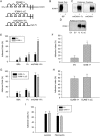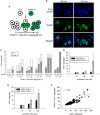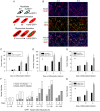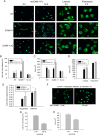Intercellular adhesion molecule-1 augments myoblast adhesion and fusion through homophilic trans-interactions
- PMID: 28698658
- PMCID: PMC5506053
- DOI: 10.1038/s41598-017-05283-3
Intercellular adhesion molecule-1 augments myoblast adhesion and fusion through homophilic trans-interactions
Abstract
The overall objective of the study was to identify mechanisms through which intercellular adhesion molecule-1 (ICAM-1) augments the adhesive and fusogenic properties of myogenic cells. Hypotheses were tested using cultured myoblasts and fibroblasts, which do not constitutively express ICAM-1, and myoblasts and fibroblasts forced to express full length ICAM-1 or a truncated form lacking the cytoplasmic domain of ICAM-1. ICAM-1 mediated myoblast adhesion and fusion were quantified using novel assays and cell mixing experiments. We report that ICAM-1 augments myoblast adhesion to myoblasts and myotubes through homophilic trans-interactions. Such adhesive interactions enhanced levels of active Rac in adherent and fusing myoblasts, as well as triggered lamellipodia, spreading, and fusion of myoblasts through the signaling function of the cytoplasmic domain of ICAM-1. Rac inhibition negated ICAM-1 mediated lamellipodia, spreading, and fusion of myoblasts. The fusogenic property of ICAM-1-ICAM-1 interactions was restricted to myogenic cells, as forced expression of ICAM-1 by fibroblasts did not augment their fusion to ICAM-1+ myoblasts/myotubes. We conclude that ICAM-1 augments myoblast adhesion and fusion through its ability to self-associate and initiate Rac-mediated remodeling of the actin cytoskeleton.
Conflict of interest statement
The authors declare that they have no competing interests.
Figures








Similar articles
-
Intercellular adhesion molecule-1 expression by skeletal muscle cells augments myogenesis.Exp Cell Res. 2015 Feb 15;331(2):292-308. doi: 10.1016/j.yexcr.2014.09.032. Epub 2014 Sep 30. Exp Cell Res. 2015. PMID: 25281303 Free PMC article.
-
Morphological changes and spatial regulation of diacylglycerol kinase-zeta, syntrophins, and Rac1 during myoblast fusion.Cell Motil Cytoskeleton. 2007 Jul;64(7):549-67. doi: 10.1002/cm.20204. Cell Motil Cytoskeleton. 2007. PMID: 17410543
-
Fibronectin promotes migration, alignment and fusion in an in vitro myoblast cell model.Cell Tissue Res. 2012 Jun;348(3):569-78. doi: 10.1007/s00441-012-1364-1. Epub 2012 Mar 18. Cell Tissue Res. 2012. PMID: 22427060
-
The fusogenic synapse at a glance.J Cell Sci. 2019 Sep 16;132(18):jcs213124. doi: 10.1242/jcs.213124. J Cell Sci. 2019. PMID: 31527149 Free PMC article. Review.
-
Role and organization of the actin cytoskeleton during cell-cell fusion.Semin Cell Dev Biol. 2016 Dec;60:121-126. doi: 10.1016/j.semcdb.2016.07.025. Epub 2016 Jul 27. Semin Cell Dev Biol. 2016. PMID: 27476112 Review.
Cited by
-
Tuning Myogenesis by Controlling Gelatin Hydrogel Properties through Hydrogen Peroxide-Mediated Cross-Linking and Degradation.Gels. 2022 Jun 17;8(6):387. doi: 10.3390/gels8060387. Gels. 2022. PMID: 35735731 Free PMC article.
-
Matrix metalloproteinase-9 (MMP9) is involved in the TNF-α-induced fusion of human M13SV1-Cre breast epithelial cells and human MDA-MB-435-pFDR1 cancer cells.Cell Commun Signal. 2018 Apr 10;16(1):14. doi: 10.1186/s12964-018-0226-1. Cell Commun Signal. 2018. PMID: 29636110 Free PMC article.
-
Myogenic Cell Expression of Intercellular Adhesion Molecule-1 Contributes to Muscle Regeneration after Injury.Am J Pathol. 2020 Oct;190(10):2039-2055. doi: 10.1016/j.ajpath.2020.06.009. Epub 2020 Jul 8. Am J Pathol. 2020. PMID: 32650005 Free PMC article.
-
Regenerating Myofibers after an Acute Muscle Injury: What Do We Really Know about Them?Int J Mol Sci. 2023 Aug 8;24(16):12545. doi: 10.3390/ijms241612545. Int J Mol Sci. 2023. PMID: 37628725 Free PMC article. Review.
-
Conserved pathway activation following xenogeneic, heterotypic fusion.FASEB J. 2019 Jun;33(6):6767-6777. doi: 10.1096/fj.201801700R. Epub 2019 Feb 26. FASEB J. 2019. PMID: 30807240 Free PMC article.
References
-
- Pavlath, G. K. Current Progress Towards Understanding Mechanisms of Myoblast Fusion in Mammals. (Springer-Verlag Berlin, Heidelberger Platz 3, D-14197 Berlin, Germany, 2011).
Publication types
MeSH terms
Substances
Grants and funding
LinkOut - more resources
Full Text Sources
Other Literature Sources
Miscellaneous

